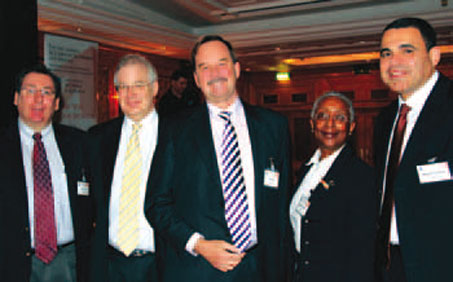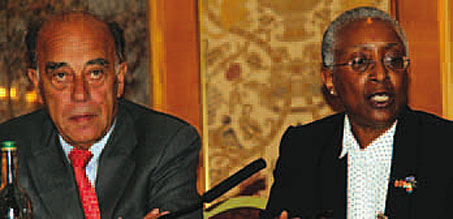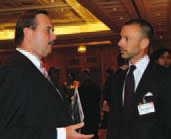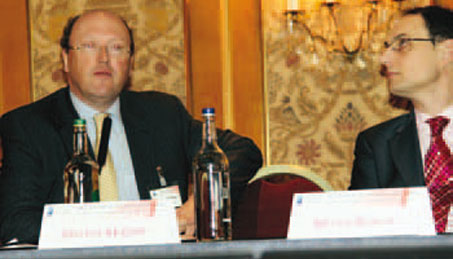
Eliot Lees, Vice President, SH&E; Chris Tarry, Aviation Industry Research & Advisory, CTAIRA; Ad Rutten, Executive Vice President & COO, Schiphol Group and President of ACI EUROPE; Angela Gittens, Director General, ACI WORLD; and Waleed Youssef, Chair, ACI WORLD Economics Standing Committee and CSO, TAV Airports Holding.
The conference once again attracted a broad range of stakeholders, including airport CEOs, CFOs, airport operators, investors and regulators. It provided an engaging forum in which to address the challenges and after-effects of the global economic downturn.
Current trends show that traffic results are improving in all regions, with the emerging BRIC (Brazil, Russia, India and China) markets leading the way. ACI WORLD Director General Angela Gittens explained that the news means the updated global outlook for growth in 2010 foresees a 3-4% upturn. “What we have not revised is that we still live in erratic times, and we face the financial impact of weak airlines, diminishing government relief packages and tight lending markets,” she said.
Passenger traffic at European airports declined by -5.9% in 2009, but promisingly, growth returned in December with a +2.2% increase year-on-year. Nevertheless, ACI EUROPE remains cautious about the outlook in 2010; the economic recovery in Europe appears fragile and the recovery of passenger traffic remains slow.
Olivier Jankovec, Director General, ACI EUROPE, said “Airports across Europe will continue to tighten their belts and cut costs to protect competitive positions. But they will also need to look beyond the crisis. The long lead time in airport development and the fact that air traffic is still expected to double by 2030 mean that airports need to start investing now to deliver the facilities that will be required tomorrow. Not an easy task after months of falling revenues and capital cost still way above pre-crisis levels.”
The ACI WORLD annual economics survey highlights a significant shift in aeronautical revenue sources from aircraft to per passenger charges. Gittens explained that airports, despite the difficult economic situation, have held user charges to airlines globally at less than 4% of airline operating costs. Meanwhile, the survey also shows that airport operating expenses reached $55 billion (€40bn) in 2008 – 57% of airport revenues.
Waleed Youssef, Chair, ACI WORLD Economics Standing Committee and CSO, TAV Airports Holding, contended that the crisis in the aviation sector is also a result of excesses in the industry, including the focus on high-premium passengers by certain air carriers. “A huge increase in passengers is expected in the next 20 years,” he said. “Airlines need to focus on long-term objectives – serve communities and their customers.”
New market structure
Ad Rutten, Executive Vice President & COO, Schiphol Group and President of ACI EUROPE outlined figures that provided some context. In addition to the -5.9% decrease in overall passenger traffic in Europe in 2009, freight traffic was down -13.1%. In total, 86% of European airports saw decreasing traffic last year. 2010, said Rutten, will see a slow and gradual recovery, with airlines to focus on yield recovery and cautious capacity growth. Rutten referred to a new market structure, with increased dominance of low-cost models. Low-cost market share will grow to +50% in 2013 and there will be even more pressure on charges than expected.
Competitive airport charges are a must and strategic directions will see differentiated facilities and services for low-cost carriers/alliances – indeed, several airports, including Bordeaux, Copenhagen and Marseille-Provence, already operate dedicated low-cost facilities. Airport alliances, such as the innovative agreements between AdP and Schiphol, and SEA Milan and ADR, will assume growing importance. From a financial perspective, Rutten called for less airline-centric and more passenger-focused economic regulation, emphasising the importance to “incentivise airports to finance infrastructure development”.
Both Rutten and Eliot Lees, Vice President, SH&E, referred to the development of new revenue streams – with a focus on commercial revenues. “As airlines’ pricing strategies evolve, airports must respond by changing and refining their own business strategies,” said Lees.
Airport financing was explored in some detail. As capital intensive businesses, airports felt the consequences of the economic crisis very severely, in terms of the ability to provide new infrastructure and capacity. Sidharath Kapur, Chief Financial Officer, GMR Airports, Delhi International Airport, explained that the impact of the crisis was felt in India in 2008/2009, and that recovery had already been seen in 2009/2010. “Construction of Delhi airport was impacted by the crisis,” said Kapur, referring to a “difficult financial situation”.
Europe has been underperforming compared to global traffic development, according to Nicolas Painvin, Head of Transportation & PP, EMEA, Fitch Ratings. He contended that large EU hubs have been less affected by the crisis and that “airlines will need to adapt to new market reality; heavy losses are unsustainable in the long-term”.
Global Infrastructure Partners (GIP) formally completed the acquisition of London-Gatwick in December for £1.5 billion (€1.65bn). Michael McGhee, Partner, GIP, explained that due to the financial crisis, rating agencies have changed their approach towards the transportation sector and airports. A £1 billion (€1.1 billion) investment will take place at the airport over the current five-year contract period.

Current trends show that traffic results are improving in all regions, with the emerging BRIC (Brazil, Russia, India and China) markets leading the way. ACI WORLD Director General Angela Gittens explained that the news means the updated global outlook for growth in 2010 foresees a 3-4% upturn.

Ad Rutten, Executive Vice President & COO, Schiphol Group and President of ACI EUROPE, with Olivier Jankovec, Director General, ACI EUROPE. Rutten explained that 2010 will see a slow and gradual recovery, with airlines to focus on yield recovery and cautious capacity growth.
Airport-Airline relationship
A key session focused on the airport-airline relationship and reconciling the long-term planning of airports with the short-term strategies of airlines. Brian Gabel, Vice President & CFO, Greater Toronto Airports Authority, presented a new approach towards consultation with airlines and a new governance structure at Toronto Airport – the aim being more efficient operations and lower costs.
“De-bundling of services is a key element of the new approach,” he said. In 2010, its airport charges will be reduced by 10%. “Transparency is key,” he said. “The board needs to be available to back the consultation process if needed.”
Offering the airline perspective, easyJet’s Rigas Doganis underlined the strong growth of LCCs: “42% of seats available in Europe are low-cost.” The consequence is increased competition and higher demands on airports. “Airport charges are very relevant for LCCs given their cost-structure and short-haul business model,” said Doganis.
ACI WORLD’s Gittens added to the discussion: “Transparency needs to be two-sided, also involving airlines providing reliable information. Airlines need to send the right staff in order to have a meaningful consultation.”
In a presentation on governance and economic oversight, David Starkie, Senior Adviser, Case Associates, questioned the need for a specific regulatory framework given the increasing competition between airports. He said that long-term contracts between airports and airlines are potentially beneficial for both sides and, in this case, there is no need for regulation. “No matter how well designed, regulation introduces distortions,” he said.
Demands on the capital intensive airport business and airport financial management have broadened over time. Today’s airport manager must balance the investment and service demands of a diverse constituency: airlines, owners, communities, passengers, management and staff. The consensus across the two-day conference was that to meet the myriad challenges facing the industry, stakeholders must marshal their resources, invest and spend wisely, and collaborate closely with industry partners to develop shared solutions.

Michael McGhee, Partner, GIP, explained that due to the financial crisis, rating agencies have changed their approach towards the transportation sector and airports.







